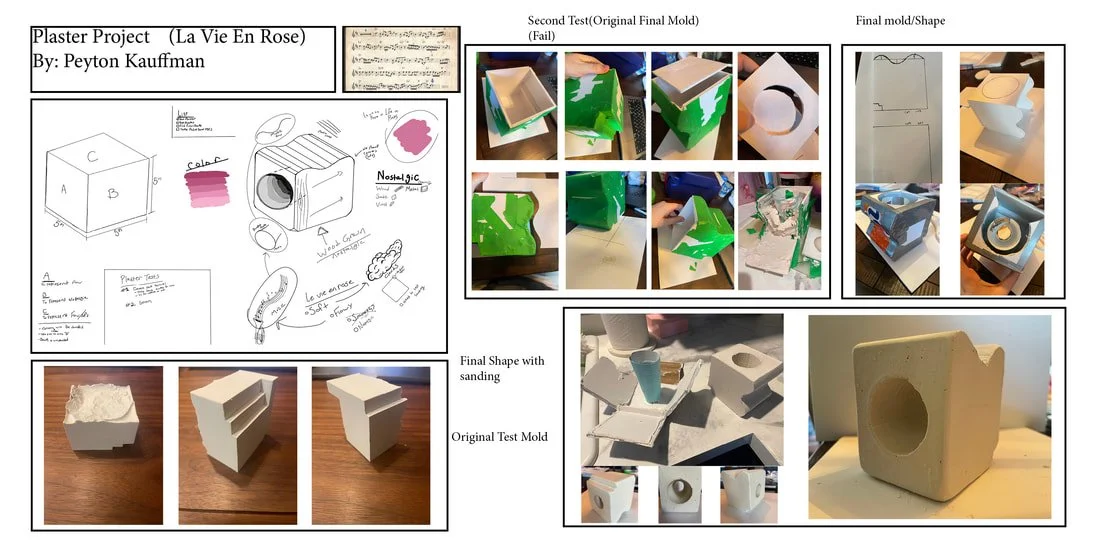
Life-Long & Life-Wide Learning
Life-long and life-wide learning in architecture is essential for maintaining a mindset of continuous growth and adaptability. This approach is critical within both the academic program and the profession, as it encourages architects to stay curious, embrace new knowledge, and adapt to evolving technologies and societal needs. As a student, I recognize the importance of expanding my learning beyond formal education, engaging with diverse experiences and interdisciplinary fields. In the future, I aim to cultivate a career where I am constantly learning, both through practice and broader life experiences, to enhance my work and contribute meaningfully to the profession.
Stand Out!
-

The Plaster Project
This was a warmup project that everyone in my studio was tasked with doing. We were asked to think outside the box and use something that inspires us to create a shape. I chose music. In the end, I acquired a new skill that was used for years to come.
-

My Book Draft
This is a significant work in progress and the test of my ability to tell a story. I've wanted to write a book for years, and I finally decided in the spring of 2024. Here, I applied all my storytelling knowledge from being at Belmont.
-

Mythica
In the first semester of my senior year, I took a theme parks class at Belmont. I, along with my best friend, who is also in architecture with me, decided that we would create a Theme Park for our final. We were asked to create a few slides, but where's the fun in that.
Related Reflections
Related Reflections
Reflection on Bell Core
September 23rd, 2024
Since my freshman year, my way of thinking has changed, not necessarily my ideas. While my idea of architecture has changed, I wouldn't say that my perception of architecture has dramatically changed due to my Bell Core. One class that definitely changed my way of thinking was Studio 1. I know it was our first studio and was meant to show us new things about architecture. Therefore, it was meant to change our ideas about it. To me, Studio 1 had a much larger impact than just that. Studio 1 opened my eyes to the possibilities of what I could come up with. It was slow at first, but before I knew it, I was working on designing a house in my Sophomore year. I was happy with what I was doing and knew I was on the path to finding my vocation. As most people know, I have always wanted to work for Disney, but before Studio 1, I had no idea if I was on the right path. Then I had Studios 2 and 3. Those classes showed me how I could truly flourish in my imagination as an architect and storyteller. The professors that lifted me up and the critiques that brought me down and allowed me to build myself back up were the moments that made Studio so impactful. Projects that dealt with helping those in need brought fun and fresh ideas to researching water and made a lady feel proud to be living in Nashville. Those projects shaped how I think and how I tackle problems inside and outside the studio. I can't look at a building without some form of judgment, and I can't watch a movie without thinking of the people who designed the sets or the background buildings in video games. They all involve architects who never let their imaginations be caged. My way of thinking has changed for the better, thanks to my Bell Core classes. The right answer may be the easiest solution, but in the wise words of my professors, "Architects never take the easy route. They've got to make it difficult, or else they don't grow."
Life-long & Life-wide Learning for the Discipline [LO-2]
November 15th, 2024
Lifelong and life-wide learning are really important in architecture because the field is constantly changing. I agree with the NAAB’s statement that inevitable changes in cultural, social, environmental, economic, and built contexts make ongoing learning essential. As architects, we need to keep up with new ideas, materials, and methods while understanding the history and theories that got us here. The body of architectural knowledge is always growing. For example, sustainable materials like mass timber are becoming more common, so architects need to learn how to use them effectively. At the same time, understanding historical and theoretical perspectives helps us create designs that respect the past while pushing boundaries for the future.
Architecture also plays a huge role in shaping the world around us. Socially, architects can help address issues like housing and community building. Culturally, our designs need to reflect and support diversity and inclusivity. Environmental challenges, like climate change, push us to think about sustainability and how our work impacts the planet. Economically, we have to make sure our designs are not just creative but also practical and affordable.
To stay current in the field, I plan to keep learning through things like workshops, internships, and staying updated on trends in architecture. I also want to work with people from different fields to bring new perspectives into my designs. Listening to what communities need and value will also be a big part of how I grow as a designer. By embracing lifelong learning, I’ll be able to adapt to the changes in architecture and make sure my work stays meaningful and relevant. It’s not just about designing buildings—it’s about understanding how to create spaces that really connect with people and the world around us.
Learning Environment [LO-3]
November 15th, 2024
Belmont's architecture program does a great job fostering a positive culture through its policies, curriculum, and the way faculty, staff, and students interact. From my experience, the program emphasizes collaboration and respect, which creates an environment where everyone feels supported and encouraged to grow. Professors are approachable and genuinely care about helping students succeed, whether through feedback on projects or sharing insights from their own professional experiences. The curriculum also supports this culture by encouraging teamwork on projects and open dialogue during critiques, which helps students learn from each other. This kind of environment is really important in an educational setting because it allows students to take risks, try new ideas, and grow both personally and professionally. When there’s a culture of respect and encouragement, students feel more confident sharing their work and pushing their creativity. It also makes the program more enjoyable because you know you’re part of a community that has your back.
Personally, I’ve tried to contribute to this positive culture by being engaged during group projects and offering constructive feedback to my classmates. I also try to stay optimistic and encourage others when things get stressful, like during deadlines or critiques. Recently, I advocated for our cohort to continue working on a current project instead of starting a new one, because I felt it would benefit everyone’s learning and give us more time to refine our designs. By staying involved and looking out for the best interests of my classmates, I hope I’ve made a small difference in keeping the program’s culture strong.
Overall, Belmont’s architecture program sets a great example of what a positive learning and teaching culture should look like, and I’m grateful to be part of it.